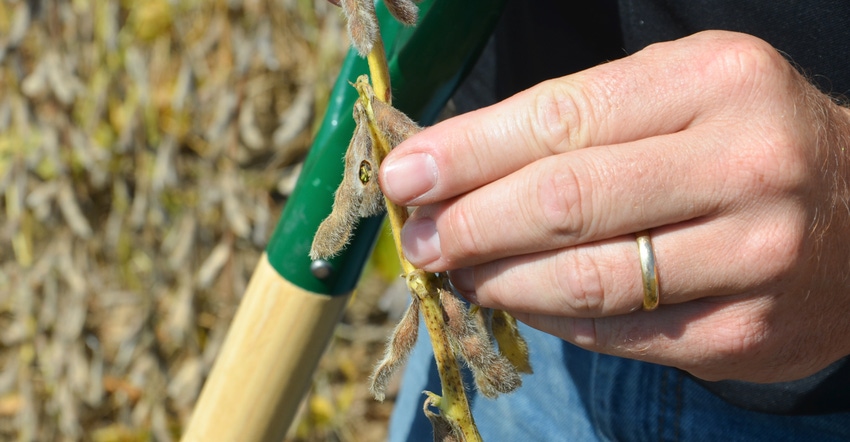
Insects are active in soybeans, agronomists report. Your job is to scout and determine if insect feeding reaches levels that justify insecticide applications.
Steve Gauck, Beck’s sales agronomist based in Greensburg, Ind., says there’s more than one insect that could cause issues in soybeans this year. Beck’s sponsors Soybean Watch ’19.
“We saw bean leaf beetle feeding on soybeans planted late earlier in the season,” he says. “As August approached, we found feeding by Japanese beetles and grasshoppers. We were also beginning to see stinkbugs, although pressures were low then.”
Because soybeans were planted so late in many cases, they were still putting on new vegetation even while flowering and forming pods. Reproductive stages are tied to photoperiod, which relates to length of nighttime. That’s why you’ll find varieties flowering and putting on pods even while they’re still growing, Gauck says.
Expect maturity to be delayed. Although soybean reproduction is strongly tied to photoperiod, late planting causes delay in maturity, Gauck explains.
Spray strategy
Gauck says he’s also keeping an eye on diseases. His suggestion is sticking with the typical recommendation of applying fungicides at the R3 stage in soybeans. You’ll need to scout to know when beans reach that stage.
According to the Purdue University Corn and Soybean Field Guide, soybeans are at R3 when you can find a pod at least one-quarter-inch long at one of the four uppermost nodes on the main stem with a completely unrolled, or flat, leaf. The same soybean growth stages apply no matter when soybeans were planted.
You can apply fungicides after R3 if conditions warrant, but both university and company research trials indicate maximum benefit year in and year out when fungicides are applied at R3.
Gauck says his plan would be to apply insecticides with fungicides on soybeans this year. “We’re seeing more insect activity than usual, and I would add the insecticide,” he says.
He adds a word of caution: Green stinkbugs can emerge until harvest. Even if you spray an insecticide with fungicide now, continue scouting. If green stinkbugs damage beans in pods and reach the treatment threshold, you could need to spray an insecticide again.
Insect by insect
Here’s a look at the most common insects present this year and treatment advice:
Bean leaf beetles. According to the Purdue guide, bean leaf beetles can be tan, yellow or red. A second generation can feed on leaves and scar pods. Pull the trigger for treatment sooner when soybeans are in the R1 to R5 stages. Treat if there is more than 15% total plant defoliation. Inspect five plants in five areas of the field to determine defoliation. From R6 on, treat if there is 5% or more damage to marketable pods and 10 or more beetles per foot of row.
Japanese beetles. Adult Japanese beetles are metallic green with bronze-colored wings. They skeletonize leaves much like Mexican bean beetles. The same defoliation guidelines apply. After R5, it takes 25% defoliation to justify treatment, the guide notes. Pod feeding is not an issue.
Grasshoppers. Grasshoppers leave irregular holes in leaves and can damage pods. The same defoliation guidelines as for bean leaf beetles and Japanese beetles apply. Spot application may be adequate for both Japanese beetles and grasshoppers.
Green stinkbugs. Adult green stinkbugs are bright green and shield-shaped. Nymphs come in a variety of colors and are wingless. Determine numbers with a sweep net. Spraying is justified if you find 40 stinkbugs per 100 sweeps. For seed beans, spray at 20 stinkbugs per 100 sweeps.
About the Author(s)
You May Also Like




